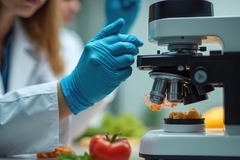
- Industry news
Industry news
- Category news
Category news
- Reports
- Key trends
- Multimedia
- Journal
- Events
- Suppliers
- Home
- Industry news
Industry news
- Category news
Category news
- Reports
- Key trends
- Multimedia
- Events
- Suppliers
Hong Kong researchers develop AI-enhanced 3D food printing tech to advance personalized nutrition

Researchers at the Hong Kong University of Science and Technology (HKUST) are advancing 3D food printing with an AI-assisted technology that combines infrared cooking with printing.
This method can enable safer, more efficient, and visually striking food production compared to traditional 3D food printing, which involves post-processing steps that can result in unappealing ingredients, imperfect shapes, and possible microbial contamination.
The research team within the university’s Division of Integrative Systems and Design (ISD) has developed an AI-enhanced system that enables extrusion-based printing with simultaneous infrared heating for on-the-fly cooking of complex starch-based foods.
The controlled process uses graphene heaters for cooking, allowing starch-based food items to keep their intended shape and quality.

“With its potential to streamline food production processes, improve food quality, and cater to individual preferences, this innovation can transform how food is prepared and served in diverse settings, paving the way for a future where personalized and visually appealing food creations are more accessible than ever before,” says Mitch Li Guijun, assistant professor of ISD and the research team lead.
“It represents a significant step forward in how we think about food creation,” Li adds.
The AI-assisted system that supports 3D printing technology uses generative algorithms and Python scripts to ink intricate food patterns. With AI, the design process becomes more accessible to common users.
Enabling customized nutrition
As personalized nutrition trends and approaches like “food as medicine” gather steam, there is a renewed focus on food-based interventions that can be integrated into specific diets.
The research team highlights the technology’s ability to open up prospects for tailored nutrition, especially for people who have difficulty swallowing food. Facilities like elder care centers and common kitchens could meet specific dietary demands, while restaurants could more efficiently tap creative culinary experiences with the HKUST innovation.
“We’ve reimagined what 3D food printing can achieve by merging technology and culinary creativity. Our cutting-edge integrative 3D food printing technology can potentially revolutionize personalized food creation,” says Connie Lee Kong-Wai, first author and a PhD scholar at the university.
The research’s interdisciplinary approach, combining learnings from user-centric design, mechanical engineering, food science, chemistry, and AI, could help tackle the complex challenges attached to 3D food printing, which remains in its early stages.
The research, titled “Advanced 3D Food Printing with Simultaneous Cooking and Generative AI Design,” has been published in the international journal Advanced Materials from Wiley.
The HKUST team has plans to improve the technology by examining the preservation of heat-sensitive vitamins and optimizing starch digestibility.
Since consumer acceptance remains a key consideration for mainstreaming alternative food production technologies, the team’s future research will also focus on sensory evaluations involving target users such as children or hospital caretakers. This will ensure that the system is ready for real-world applications.
Meanwhile, the F&B sector is increasingly exploring 3D food printing to replicate the flavors and mouthfeel of conventional meat in the alt-protein space. For example, Steakholder Foods’ new demonstration center allows customers to see how its 3D printers formulate meat and seafood alternatives in real time before purchasing the equipment.











